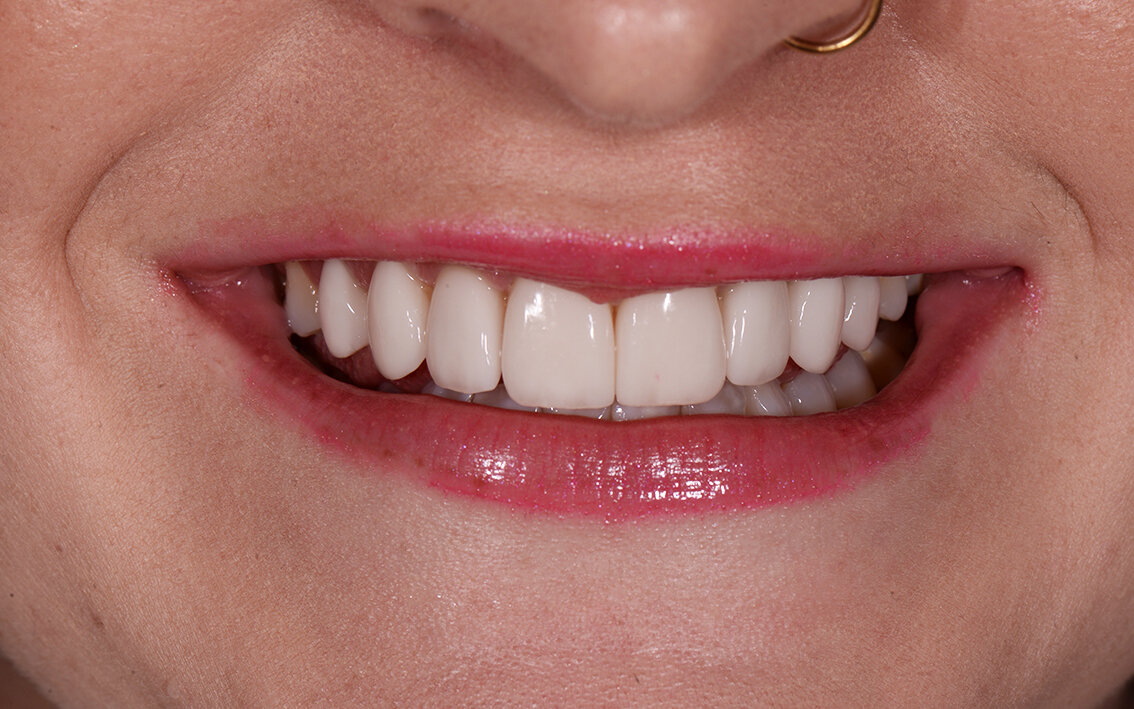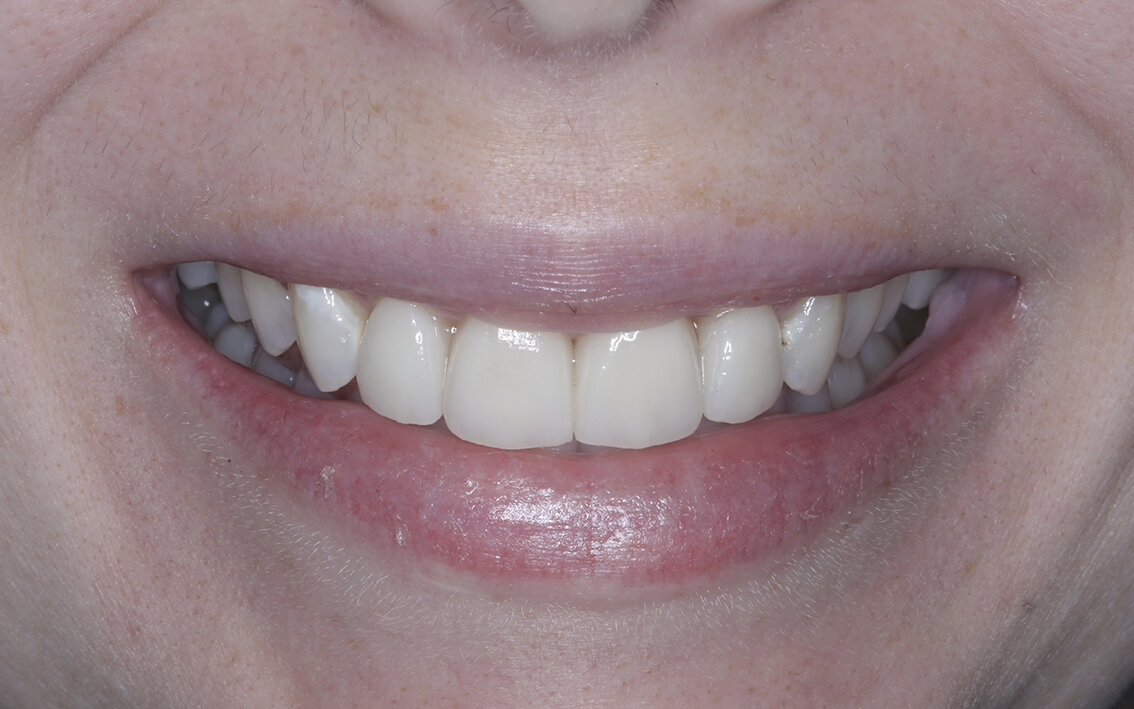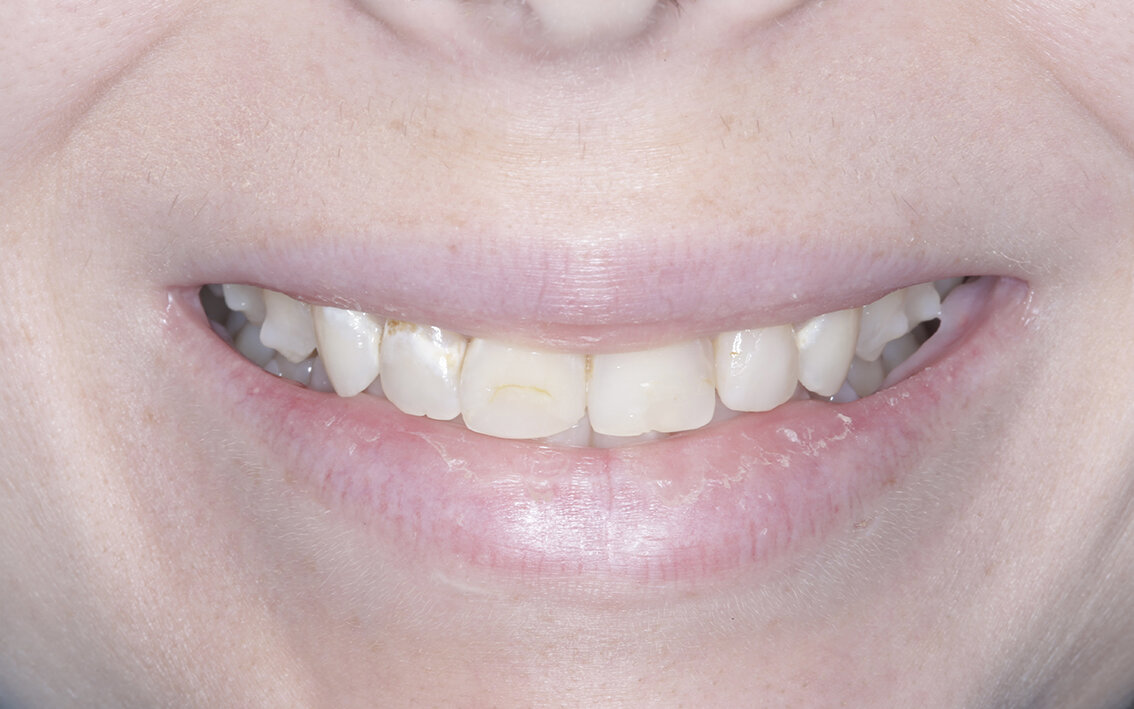Why might my dentist recommend porcelain veneers?
Porcelain veneers are custom-built porcelain shells that bond to the front and biting surface of teeth. Porcelain veneers are extremely conservative, and often require only minimal removal of tooth-structure.
Under the right circumstances porcelain veneers are extremely durable, long-lasting restorations. They can alter the shape, colour, length and width of a tooth - achieving a dramatic difference to your smile.
Why would I want a veneer over a dental crown?
Like dental crowns, a veneer can alter the colour, shape and appearance of a tooth when viewed from the front. It helps to compare a veneer to a “fake nail”, while a crown encompasses the whole tooth like a “thimble” which covers the entire finger.
If only a cosmetic change is required veneers are may be the most conservative choice as they require less tooth removal than crowns. This is for two reasons:
Veneers only cover the part of the tooth that is visible to the outside world - hence the surface between the teeth and on the inside of the mouth can often be left untouched.
Veneers need to be enamel-bonded hence are quite superficial - Whilst a crown stays in place by height and taper of the crown preparation, a veneer preparation is non-retentive and relies entirely on the strength of adhesives.
A veneer is a thin shell of ceramic and borrows its strength by being glued to the underlying enamel. When preparing a tooth for a veneer, the dentist must not prepare the tooth into dentine, as this will compromise the bonding of veneers and their associated longevity.
If there is a functional reason that a crown may be required (i.e. heavily filled tooth or cracks in residual tooth structure) or enamel is not present at the gum-line (such as teeth with gum-recession) then a crown may still be the best choice. Also in the case of drastically discoloured teeth (such as tetracycline staining) then crowns may still be preferable over veneers. This is because crowns are generally thicker and have an increased ability to hide severe discolouration.
Is there a recognised speciality in dental veneers? ⬇️
A Prosthodontist is a board-registered specialist in restorative treatment, including crowns, veneers and bridges. Any other stated qualification (i.e. cosmetic dentist, neuromuscular dentist, etc) is a self-dubbed title and just means the dentist has an interest in that procedure.
It would be reasonable to expect that a Prosthodontist would be more skilled in both the diagnostic and procedural aspects of dental veneers. They are also highly aware of the biological costs of such procedures and will discuss other suitable, conservative alternatives where appropriate.
How many appointments does a veneer take? ⬇️
Treatment of a tooth with a veneer generally takes two visits which are three weeks apart:
- At the first appointment, the tooth is shaped to receive a veneer. The tooth is shaped with a 0.5-0.7mm reduction from the final tooth outline in order to create space for the future veneer. At the conclusion of this appointment we make you a temporary veneer so that you can smile, talk and eat as well if not better than you did before while the final veneer is made.
- At the second appointment the veneer is tried-in, adjusted and cemented.
There is generally a three-week space between the preparation and cementation appointment - this is the time it takes to get a premium lab to make dental veneers that we would be comfortable to put our name to.
I have seen “cheap veneers” or “same-day veneers” advertised online - why should I avoid these? ⬇️
At Queensland Prosthodontics our focus is to produce the best veneers possible for our patients - that is use the best materials, techniques and dental technicians we can source. If sending Dental work overseas or using chair-side milling machines improved our quality we would do it! Unfortunately this is not the case and all these approaches do is increase the profit-margin for the treating clinician - not the quality for the patient!
Dental Laboratories that make “cheap veneers and crowns” often send their work to China (such as Southern Cross Dental Laboratory), use non-skilled labour or mill the veneers in the dental office using a CNC machine. Each of these cost-cutting measures compromises the longevity, biocompatibility and aesthetics of a crown.
“Same –day veneers” are made in the dental surgery by a milling machine (i.e. Cerec, E4D). These veneers are literally carved out of a solid block of ceramic that is one flat colour. These types of restorations only take one appointment and are cheaper as they eliminate the expense of sending work to a dental laboratory. There are a number of drawbacks to this treatment approach:
- Same-day veneers tend not to fit as well which is a problem for gum inflammation, dental decay and tooth-sensitivity.
- They don’t look like natural teeth - the are milled out of a sold block of ceramic, hence they are one solid colour and tend to be quite opaque.
- Milled ceramic requires a minimum thickness that is thicker than a cast-veneer, hence tooth-reduction has to be more aggressive.
All our veneers, crowns and bridges are hand-made by premium dental laboratories and there is a fair bit of skill that goes into each and every tooth. As such our dental technicians charge a premium for their time, skill and use of the best materials and this cost is reflected in our fees.
My veneers keep popping-off and need to be re-cemented. Why is this? ⬇️
If a veneer prematurely comes loose then one would question how adequately the adhesive has been applied to the tooth and/ or veneer. If this happens on multiple occasions then we would be suspicious that the dentist was a bit heavy-handed with the tooth preparation and the veneer is in-fact bonded to dentine.
In theory veneers should be preferablyenamel-bonded. Unlike Dentine, enamel is not a living structure and cannot dissolve the bonding layer applied with dental adhesives. A second factor is ceramics and enamel are rigid, whilst the dentine is flexible.
When Enamel and ceramics are bonded together they share strength from each other. When ceramic is bonded to dentine, the dentine can flex whilst the ceramic cannot resulting in eventual fracture of the adhesive layer and premature de-cementation. If this is the case often the only solution is to replace the veneer with a crown and extend the preparation underneath the gum line.
Veneers Gallery





